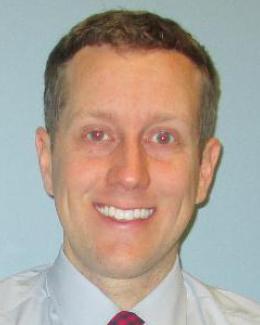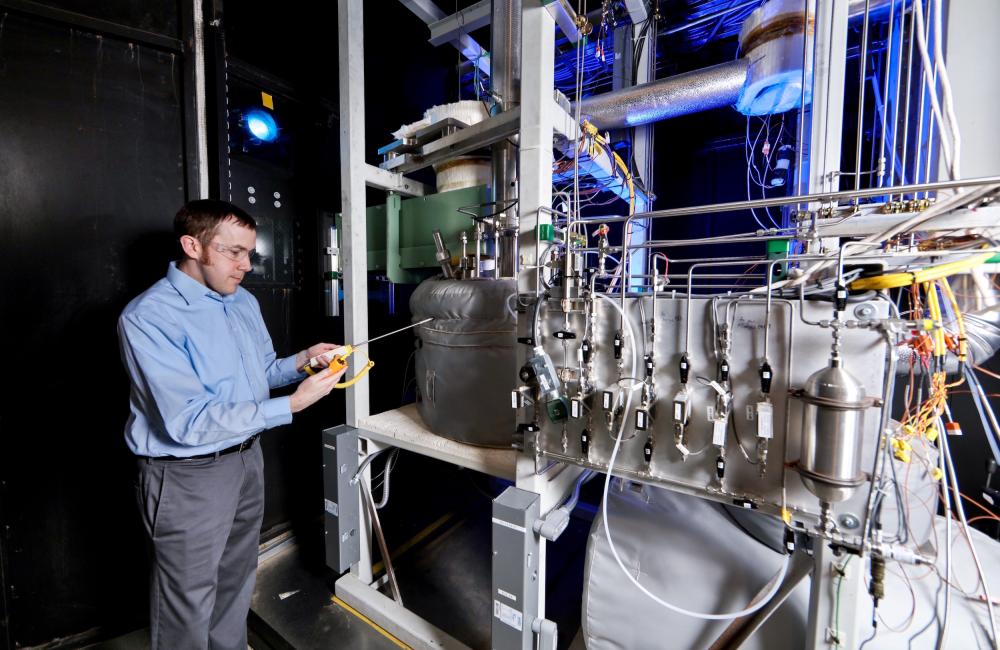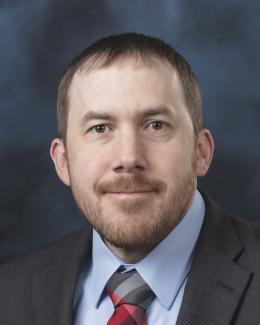May 15, 2018 — Thanks in large part to developing and operating a facility for testing molten salt reactor (MSR) technologies, nuclear experts at the Energy Department’s Oak Ridge National Laboratory (ORNL) are now tackling the next generation of another type of clean energy—concentrating solar thermal power (CSP).
The Energy Department’s Solar Energy Technologies Office selected the ORNL-based team to develop a molten chloride salt facility as part of the Generation 3 Concentrating Solar Power Systems (Gen3 CSP) program. The Gen3 CSP program supports research in materials and facilities that could allow future CSP plants to operate at higher temperatures and lower the cost of electricity production.
Kevin Robb, a staff scientist in ORNL’s Reactor and Nuclear Systems Division, will lead the investigation into a chloride salt CSP heat transfer fluid. Robb’s nuclear-focused research uses the Liquid Salt Test Loop, a one-of-a-kind test facility that heats fluoride salts to around 700 degrees Celsius and then pumps the salts through the loop. The loop is helping researchers develop and analyze technologies that industry could one day use in fluoride salt-cooled high-temperature reactors, a type of MSR.
We developed the loop with maximum flexibility in mind, so we could test numerous materials and components for possible deployment,” Robb said. “As we learned more about the CSP program, it was obvious we could leverage that experience to do the same thing for them.”
Robb and Gen3 CSP project collaborators from the University of Utah, Virginia Tech and Argonne National Laboratory will develop the solar-based loop, with salts and parts different from those found in the Liquid Salt Test Loop.
The team will design the facility to circulate heated chloride salts throughout the system. The goal is to offer extreme versatility via interchangeability of parts—from seals and pumps to valves and heat exchangers—providing researchers a variety of options to determine what works best in the loop, while avoiding pitfalls that could shorten the lifespan of a full-scale CSP plant. In commercial CSP plants, the hot chloride salts could be readily stored in tanks to generate fully dispatchable electricity at any time of day or night.
“Our research at the liquid salt facility focuses on maintaining low corrosion rates throughout the system,” Robb said. “We’ll analyze how different parts interact with the salt, and we’ll test corrosion mitigation tactics to simulate how this could work in a CSP plant.”
In addition, the facility will operate at temperatures above 725 degrees Celsius. This increased temperature will increase the efficiency of heat-to-electricity conversion to provide an economic advantage over current CSP systems that normally operate below 600 degrees Celsius. The end result could be a CSP system with greater electricity output at lower costs.
The Gen3 CSP program seeks to eliminate current knowledge and technology gaps, so that industry could use the design to bring cheap solar power to the grid in a rapid timeframe. This work could put the solar industry closer to reaching DOE’s goal of reducing the cost of CSP energy to 5 cents/kilowatt hour by 2030.
For Robb, the new project is at home within the walls of ORNL thanks to the institutional knowledge and capabilities developed over more than 50 years of work in liquid-salt energy systems—whether for nuclear or solar.
“ORNL is synonymous with MSRs because of the Molten Salt Reactor Experiment and the massive amount of research before and after that project,” he said. “When interest in MSR technologies from the nuclear industry resurged, we were ready to lead the charge. Now we’re seeing synergies in the technology needed for MSR facilities for reactor applications and Gen3 CSP and we’re ready to answer this call and take on a new challenge.”
The project is funded by the U.S. Department of Energy Solar Energy Technologies Office. ORNL is managed by UT-Battelle for the US Department of Energy’s Office of Science, the single largest supporter of basic research in the physical sciences in the United States. DOE’s Office of Science is working to address some of the most pressing challenges of our time. For more information, please visit https://energy.gov/science.




